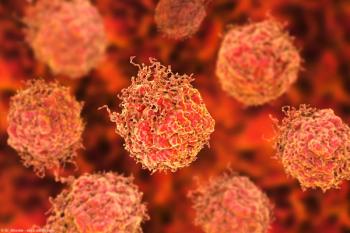
PET imaging agent found superior to CT for lymph node staging in prostate cancer
Agent shows statistically significant superiority to conventional computed tomography.
Positron emission tomography (PET) imaging with fluorine 18 (18F)–rhPSMA-7.3 is superior to morphological imaging with computerized tomography (CT) for lymph node (LN) staging in patients with primary intermediate- and high-risk prostate cancer, according to the findings of a retrospective study presented at the 2020 American Urological Association Virtual Experience.1
The data from an initial clinical evaluation of the diagnostic efficacy of the investigational radiohybrid 18F-labeled PSMA-7.3 ligand was reported by Tobias Maurer, MD, a urology specialist at the Martini-Klinik prostate cancer center at the University of Hamburg-Eppendorf in Germany.
“68Ga-PSMA PET imaging has become a common method for primary staging of prostate cancer in Europe,” Maurer said. “Although our evaluation of 18F-rhPSMA-7.3 PET imaging is a retrospective analysis, the findings demonstrating its performance are consistent with evidence from studies reporting increased LN detection rates using 68GA-PSMA PET imaging compared with CT.”
Radiohybrid PSMA ligands are a new class of diagnostic/therapeutic PSMA-targeting agents that can be efficiently labeled with 18F. Compared with Ga-labeled PSMA tracers, the 18F-radiohybrid PSMA ligand has several advantages, according to Maurer.
“18F labeled PSMA ligands have a longer half-life, larger batch production, and lower positron range that results in a higher PET image resolution,” he explained. “In addition, radiohybrids have negligible urinary excretion that allows evaluation of the small pelvis without urinary background.”
The first rhPSMA agent evaluated in the clinic, 18F-rhPSMA-7, comprises 4 isomers, and 18F-rhPSMA-7.3 was chosen for clinical development based on findings from preclinical studies. The clinical study investigating the efficacy of 18F-rhPSMA-7.3 PET imaging included 56 consecutive patients with intermediate- or high-risk prostate cancer as defined by the D’Amico risk classification system. All the men underwent the PET imaging and conventional cross-section morphological imaging prior to undergoing radical prostatectomy with a template-based extended LN dissection.
The median injected activity of the tracer was 349 MBq. The median uptake time was 72 minutes, which indicates that the procedure could be nicely integrated in the clinical workflow, Maurer told Urology Times®.
The median number of LNs removed per patient was 21. On pathology, 18 patients (32%) had metastases, of whom 15 had pelvic LN metastases and 3 had bone metastases. The number of pelvic LN metastases present per patient ranged up to 19, and the metastases were located in 33 of 319 templates (10.3%).
The presence of LN metastases on imaging was done by an experienced reader independently for the PET and morphological data sets. The diagnostic accuracy of the 2 imaging techniques was determined by comparing their results to histological findings in template-based, patient-based, and side-based (right/left) analyses.
In all 3 analyses, 18F-rhPSMA-7.3 PET imaging demonstrated statistically significant superiority to conventional CT imaging for detecting LN metastases. The values for area under the receiver operating characteristic curve for 18F-rhPSMA-7.3 PET imaging and CT were 0.842 and 0.697, respectively, for the patient-based analysis (P < .05); 0.843 and 0.631, respectively, for the right/left-based analysis (P < .001); and 0.801 and 0.639, respectively, for the template-based analysis (P < .001).
Disclosure: Blue Earth Diagnostics Ltd provided funding for the study.
Reference
1. Maurer T, Langbein T, Kroenke M, et al. Diagnostic efficacy of 18F-rhPSMA-7.3 imaging for N-staging patients with high-risk prostate cancer. Paper presented at: 2020 American Urological Association Virtual Experience. Abstract MP62-17
Newsletter
Stay current with the latest urology news and practice-changing insights — sign up now for the essential updates every urologist needs.


















